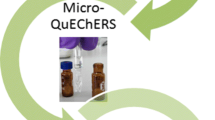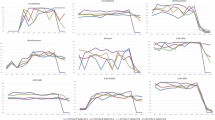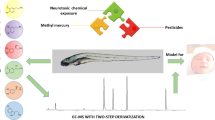Abstract
An analytical method using high-performance liquid chromatography–tandem mass spectrometry was developed to determine internal concentrations of 34 test compounds such as pharmaceuticals and pesticides in zebrafish embryos (ZFE), among them, cimetidine, 2,4-dichlorophenoxyacetic acid, metoprolol, atropine and phenytoin. For qualification and quantification, multiple reaction monitoring mode was used. The linear range extends from 0.075 ng/mL for thiacloprid and metazachlor and 7.5 ng/mL for coniine and clofibrate to 250 ng/mL for many of the test compounds. Matrix effects were strongest for nicotine, but never exceeded ±20 % for any of the developmental stages of the ZFE. Method recoveries ranged from 90 to 110 % from an analysis of nine pooled ZFE. These findings together with the simple sample preparation mean this approach is suitable for the determination of internal concentrations from only nine individual ZFE in all life stages up to 96 h post-fertilization. Exemplarily, the time course of the internal concentrations of clofibric acid, metribuzin and benzocaine in ZFE was studied over 96 h, and three different patterns were distinguished, on the basis of the speed and extent of uptake and whether or not a steady state was reached. Decreasing internal concentrations may be due to metabolism in the ZFE.

Quantification of polar pollutants in different life stages of the zebrafish embryo by LC-MS/MS






Similar content being viewed by others
References
Ali S, Champagne DL, Spaink HP, Richardson MK (2011) Zebrafish embryos and larvae: a new generation of disease models and drug screens. Birth Defects Res C 93:115–133
Lieschke GJ, Currie PD (2007) Animal models of human disease: zebrafish swim into view. Nat Rev Genet 8:353–367
Scholz S, Fischer S, Gundel U, Küster E, Luckenbach T, Voelker D (2008) The zebrafish embryo model in environmental risk assessment--applications beyond acute toxicity testing. Environ Sci Pollut R 15:394–404
Sipes NS, Padilla S, Knudsen TB (2011) Zebrafish-as an integrative model for twenty-first century toxicity testing. Birth Defects Res C 93:256–267
Van den Bulck K, Hill A, Mesens N, Diekman H, De Schaepdrijver L, Lammens L (2011) Zebrafish developmental toxicity assay: a fishy solution to reproductive toxicity screening, or just a red herring? Reprod Toxicol 32:213–219
Ali S, Champagne DL, Richardson MK (2012) Behavioral profiling of zebrafish embryos exposed to a panel of 60 water-soluble compounds. Behav Brain Res 228:272–283
Ali S, van Mil HG, Richardson MK (2011) Large-scale assessment of the zebrafish embryo as a possible predictive model in toxicity testing. PLoS One 6:e21076
Padilla S, Corum D, Padnos B, Hunter DL, Beam A, Houck KA, Sipes N, Kleinstreuer N, Knudsen T, Dix DJ, Reif DM (2012) Zebrafish developmental screening of the ToxCast (TM) Phase I chemical library. Reprod Toxicol 33:174–187
Lammer E, Carr GJ, Wendler K, Rawlings JM, Belanger SE, Braunbeck T (2009) Is the fish embryo toxicity test (FET) with the zebrafish (Danio rerio) a potential alternative for the fish acute toxicity test? Comp Biochem Physiol C 149:196–209
OECD (2013) OECD test no. 236: fish embryo acute toxicity (FET) test. OECD Publishing
Carlsson G, Patring J, Kreuger J, Norrgren L, Oskarsson A (2013) Toxicity of 15 veterinary pharmaceuticals in zebrafish (Danio rerio) embryos. Aquat Toxicol 126:30–41
van den Brandhof EJ, Montforts M (2010) Fish embryo toxicity of carbamazepine, diclofenac and metoprolol. Ecotoxicol Environ Saf 73:1862–1866
Weigt S, Huebler N, Strecker R, Braunbeck T, Broschard TH (2011) Zebrafish (Danio rerio) embryos as a model for testing proteratogens. Toxicology 281:25–36
Escher BI, Ashauer R, Dyer S, Hermens JL, Lee JH, Leslie HA, Mayer P, Meador JP, Warne MS (2011) Crucial role of mechanisms and modes of toxic action for understanding tissue residue toxicity and internal effect concentrations of organic chemicals. Integr Environ Assess Manag 7:28–49
Escher BI, Hermens JLM (2004) Internal exposure: Linking bioavailability to effects. Environ Sci Technol 38:455a–462a
El-Amrani S, Pena-Abaurrea M, Sanz-Landaluze J, Ramos L, Guinea J, Camara C (2012) Bioconcentration of pesticides in Zebrafish eleutheroembryos (Danio rerio). Sci Total Environ 425:184–190
Gonzalo-Lumbreras R, Sanz-Landaluze J, Guinea J, Camara C (2012) Miniaturized extraction methods of triclosan from aqueous and fish roe samples. Bioconcentration studies in zebrafish larvae (Danio rerio). Anal Bioanal Chem 403:927–937
Stanley KA, Curtis LR, Simonich SLM, Tanguay RL (2009) Endosulfan I and endosulfan sulfate disrupts zebrafish embryonic development. Aquat Toxicol 95:355–361
Jones HS, Trollope HT, Hutchinson TH, Panter GH, Chipman JK (2012) Metabolism of ibuprofen in zebrafish larvae. Xenobiotica 42:1069–1075
Hu G, Siu SO, Li S, Chu IK, Kwan YW, Chan SW, Leung GP, Yan R, Lee SM (2012) Metabolism of calycosin, an isoflavone from Astragali Radix, in zebrafish larvae. Xenobiotica 42:294–303
Alderton W, Berghmans S, Butler P, Chassaing H, Fleming A, Golder Z, Richards F, Gardner I (2010) Accumulation and metabolism of drugs and CYP probe substrates in zebrafish larvae. Xenobiotica 40:547–557
Kretschmann A, Ashauer R, Preuss TG, Spaak P, Escher BI, Hollender J (2011) Toxicokinetic model describing bioconcentration and biotransformation of diazinon in Daphnia magna. Environ Sci Technol 45:4995–5002
Kühnert A, Vogs C, Altenburger R, Küster E (2013) The internal concentration of organic substances in fish embryos--a toxicokinetic approach. Environ Toxicol Chem 32:1819–1827
El-Amrani S, Sanz-Landaluze J, Guinea J, Camara C (2013) Rapid determination of polycyclic aromatic hydrocarbons (PAHs) in zebrafish eleutheroembryos as a model for the evaluation of PAH bioconcentration. Talanta 104:67–74
Usenko CY, Robinson EM, Bruce ED, Usenko S (2013) Uptake and metabolism of individual polybrominated diphenyl ether congeners by embryonic zebrafish. Environ Toxicol Chem 32:1153–1160
Carlsson G, Orn S, Larsson DGJ (2009) Effluent from bulk drug production is toxic to aquatic vertebrates. Environ Toxicol Chem 28:2656–2662
ISO (1996) Water quality—determination of the acute lethal toxicity of substances to a freshwater fish. ISO 7346-1
Kimmel CB, Ballard WW, Kimmel SR, Ullmann B, Schilling TF (1995) Stages of embryonic-development of the zebrafish. Dev Dyn 203:253–310
Westerfield M (2000) The zebrafish book. A guide for the laboratory use of zebrafish (Danio rerio), vol 4. University of Oregon Press, Eugene
Bluthgen N, Zucchi S, Fent K (2012) Effects of the UV filter benzophenone-3 (oxybenzone) at low concentrations in zebrafish (Danio rerio). Toxicol Appl Pharmacol 263:184–194
Epel D, Luckenbach T, Stevenson CN, Macmanus-Spencer LA, Hamdoun A, Smital T (2008) Efflux transporters: newly appreciated roles in protection against pollutants. Environ Sci Technol 42:3914–3920
Meinertz JR, Gingerich WH, Allen JL (1991) Metabolism and elimination of benzocaine by rainbow-trout, Oncorhynchus-Mykiss. Xenobiotica 21:525–533
Acknowledgments
This work is part of the research topic “Chemicals in the Environment” (CITE) within the research programme of the Helmholtz Centre for Environmental Research–UFZ. We thank C. Petzold and J. Müller for their support in laboratory work and S. Scholz for helpful discussions on ZFE testing and toxicokinetics.
Author information
Authors and Affiliations
Corresponding author
Electronic supplementary material
Below is the link to the electronic supplementary material.
ESM 1
(PDF 521 kb)
Rights and permissions
About this article
Cite this article
Brox, S., Ritter, A.P., Küster, E. et al. A quantitative HPLC–MS/MS method for studying internal concentrations and toxicokinetics of 34 polar analytes in zebrafish (Danio rerio) embryos. Anal Bioanal Chem 406, 4831–4840 (2014). https://doi.org/10.1007/s00216-014-7929-y
Received:
Revised:
Accepted:
Published:
Issue Date:
DOI: https://doi.org/10.1007/s00216-014-7929-y




